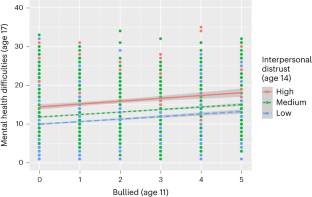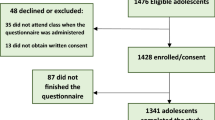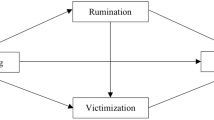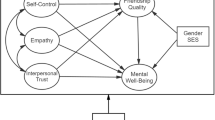Abstract
Social Safety Theory predicts that socially threatening experiences such as bullying degrade mental health partly by fostering the belief that others cannot be trusted. Here we tested this prediction by examining how peer bullying in childhood impacted adolescent mental health, and whether this effect was mediated by interpersonal distrust and several other commonly studied mediators—namely diet, sleep and physical activity—in 10,000 youth drawn from the UK’s Millennium Cohort Study. Youth bullied in childhood developed more internalizing, externalizing and total mental health problems in late adolescence, and this effect was partially mediated by interpersonal distrust during middle adolescence. Indeed, adolescents who developed greater distrust were approximately 3.5 times more likely to subsequently experience clinically significant mental health problems than those who developed less distrust. Individual and school-based interventions aimed at reducing the negative impact of bullying on mental health may thus benefit from bolstering youths’ sense of trust in others.
This is a preview of subscription content, access via your institution
Access options
Subscribe to this journal
Receive 12 digital issues and online access to articles
$59.00 per year
only $4.92 per issue
Buy this article
- Purchase on Springer Link
- Instant access to full article PDF
Prices may be subject to local taxes which are calculated during checkout



Similar content being viewed by others
Data availability
The data that support the findings of the present study are publicly available from the Millennium Cohort Study (UK Data Service) by application, under license. For further information on how to obtain the dataset, visit the UK Data Service website (https://ukdataservice.ac.uk/) or the relevant website of the Centre for Longitudinal Studies (https://cls.ucl.ac.uk/cls-studies/millennium-cohort-study/).
Code availability
Details of all the variable names, their processing and the full output of the R code are available on the Open Science Framework website (https://osf.io/zjq9a; ref. 5 in the Supplementary Information). D.I.T. accessed the data and wrote the code.
References
Bitsko, R. H. et al. Mental health surveillance among children—United States, 2013–2019. MMWR Suppl. 71, 1–42 (2022).
Ravens-Sieberer, U. et al. Impact of the COVID-19 pandemic on quality of life and mental health in children and adolescents in Germany. Eur. Child Adolesc. Psychiatry 31, 879–889 (2022).
Newlove-Delgado, T. et al. Child mental health in England before and during the COVID-19 lockdown. Lancet Psychiatry 8, 353–354 (2021).
Auerbach, R. P. et al. WHO World Mental Health Surveys International College Student Project: prevalence and distribution of mental disorders. J. Abnorm. Psychol. 127, 623–638 (2018).
Racine, N. et al. Global prevalence of depressive and anxiety symptoms in children and adolescents during COVID-19: a meta-analysis. JAMA Pediatr. 175, 1142–1150 (2021).
Youth Risk Behavior Survey: Data Summary and Trends Report (Center for Disease Control and Prevention, 2023).
Jones, S. et al. Mental health, suicidality, and connectedness among high school students during the COVID-19 pandemic—Adolescent Behaviors and Experiences Survey, United States, January–June 2021. MMWR Suppl. 71, 16–21 (2022).
Slavich, G. M. Social safety theory: a biologically based evolutionary perspective on life stress, health, and behavior. Annu. Rev. Clin. Psychol. 16, 265–295 (2020).
Slavich, G. M. Social Safety Theory: understanding social stress, disease risk, resilience, and behavior during the COVID-19 pandemic and beyond. Curr. Opin. Psychol. 45, 101299 (2022).
Slavich, G. M. et al. Social Safety Theory: conceptual foundation, underlying mechanisms, and future directions. Health Psychol. Rev. 17, 5–59 (2023).
Gilbert, P. et al. Feeling safe and content: a specific affect regulation system? Relationship to depression, anxiety, stress, and self-criticism. J. Posit. Psychol. 3, 182–191 (2008).
Hostinar, C. E., Sullivan, R. M. & Gunnar, M. R. Psychobiological mechanisms underlying the social buffering of the hypothalamic–pituitary–adrenocortical axis: a review of animal models and human studies across development. Psychol. Bull. 140, 256–282 (2014).
Slavich, G. M. & Irwin, M. R. From stress to inflammation and major depressive disorder: a social signal transduction theory of depression. Psychol. Bull. 140, 774–815 (2014).
Chen, G. Y. & Nuñez, G. Sterile inflammation: sensing and reacting to damage. Nat. Rev. Immunol. 10, 826–837 (2010).
Blascovich, J. & Mendes, W. B. in Handbook of Social Psychology Vol. 1, 5th edn 194–227 (John Wiley & Sons, 2010).
Flouri, E. et al. Prenatal and childhood adversity and inflammation in children: a population-based longitudinal study. Brain Behav. Immun. 87, 524–530 (2020).
Iob, E. et al. Adverse childhood experiences and severity levels of inflammation and depression from childhood to young adulthood: a longitudinal cohort study. Mol. Psychiatry 27, 2255–2263 (2022).
Furman, D. et al. Chronic inflammation in the etiology of disease across the life span. Nat. Med. 25, 1822–1832 (2019).
Arseneault, L. Annual Research Review: the persistent and pervasive impact of being bullied in childhood and adolescence: implications for policy and practice. J. Child Psychol. Psychiatry 59, 405–421 (2018).
Stewart, J. G. et al. Peer victimization and suicidal thoughts and behaviors in depressed adolescents. J. Abnorm. Child Psychol. 46, 581–596 (2018).
Sinclair, H. C., Wilson, K. J. & Stubbs-Richardson, M. Advances in youth bullying research. Front. Psychol. 13, 860887 (2022).
Biswas, T. et al. Global variation in the prevalence of bullying victimisation amongst adolescents: role of peer and parental supports. EClinicalMedicine 20, 100276 (2020).
Wolke, D. & Lereya, S. T. Long-term effects of bullying. Arch. Dis. Child. 100, 879–885 (2015).
Gini, G. & Pozzoli, T. Bullied children and psychosomatic problems: a meta-analysis. Pediatrics 132, 720–729 (2013).
Sweeting, H. et al. Peer victimization and depression in early–mid adolescence: a longitudinal study. Br. J. Educ. Psychol. 76, 577–594 (2006).
Lereya, S. T. et al. Being bullied during childhood and the prospective pathways to self-harm in late adolescence. J. Am. Acad. Child Adolesc. Psychiatry 52, 608–618.e2 (2013).
Copeland, W. E. et al. Adult psychiatric outcomes of bullying and being bullied by peers in childhood and adolescence. JAMA Psychiatry 70, 419–426 (2013).
Sharpe, H. et al. Changes in peer and sibling victimization in early adolescence: longitudinal associations with multiple indices of mental health in a prospective birth cohort study. Eur. Child Adolesc. Psychiatry 31, 737–746 (2022).
Moore, S. E. et al. Consequences of bullying victimization in childhood and adolescence: a systematic review and meta-analysis. World J. Psychiatry 7, 60–76 (2017).
Vaillancourt, T. et al. Longitudinal links between childhood peer victimization, internalizing and externalizing problems, and academic functioning: developmental cascades. J. Abnorm. Child Psychol. 41, 1203–1215 (2013).
Schoeler, T. et al. Quasi-experimental evidence on short- and long-term consequences of bullying victimization: a meta-analysis. Psychol. Bull. 144, 1229–1246 (2018).
van Geel, M. et al. Does peer victimization predict low self-esteem, or does low self-esteem predict peer victimization? Meta-analyses on longitudinal studies. Dev. Rev. 49, 31–40 (2018).
Young-Jones, A. et al. Bullying affects more than feelings: the long-term implications of victimization on academic motivation in higher education. Social Psychology of Education 18, 185–200 (2015).
Gaffney, H., Ttofi, M. M. & Farrington, D. P. Evaluating the effectiveness of school-bullying prevention programs: an updated meta-analytical review. Aggress. Violent Behav. 45, 111–133 (2019).
Menesini, E. & Salmivalli, C. Bullying in schools: the state of knowledge and effective interventions. Psychol. Health Med. 22, 240–253 (2017).
Gaffney, H., Ttofi, M. M. & Farrington, D. P. What works in anti-bullying programs? Analysis of effective intervention components. J. School Psychol. 85, 37–56 (2021).
Marsh, H. W. et al. Peer victimization: an integrative review and cross-national test of a tripartite model. Educ. Psychol. Rev. 35, 46 (2023).
Bonell, C. et al. Effects of the Learning Together intervention on bullying and aggression in English secondary schools (INCLUSIVE): a cluster randomised controlled trial. Lancet 392, 2452–2464 (2018).
Herkama, S. et al. Sleeping problems partly mediate the association between victimization and depression among youth. J. Child Family Stud. 28, 2477–2486 (2019).
Sosnowski, D. W., Kliewer, W. & Lepore, S. J. The role of sleep in the relationship between victimization and externalizing problems in adolescents. J. Youth Adolesc. 45, 1744–1754 (2016).
Lee, K. S. & Vaillancourt, T. Developmental pathways between peer victimization, psychological functioning, disordered eating behavior, and body mass index: a review and theoretical model. Aggress. Violent Behav. 39, 15–24 (2018).
Storch, E. A. et al. Peer victimization, psychosocial adjustment, and physical activity in overweight and at-risk-for-overweight youth. J. Pediatr. Psychol. 32, 80–89 (2007).
Eisenberg, M. & Neumark-Sztainer, D. Peer harassment and disordered eating. Int. J. Adolesc. Med. Health 20, 155–164 (2008).
Liang, K. et al. Food insecurity and bullying victimization among 170,618 adolescents in 59 countries. Front. Psychiatry 12, 766804 (2021).
Uslaner, E. M. The Moral Foundations of Trust (Cambridge Univ. Press, 2002).
Rotenberg, K. J. in International Encyclopedia of the Social & Behavioral Sciences (eds Smelser, N. J. & Baltes, P. B.) 7866–7868 (Pergamon, 2001).
Neil, L. et al. Trust and childhood maltreatment: evidence of bias in appraisal of unfamiliar faces. J. Child Psychol. Psychiatry 63, 655–662 (2022).
Turagabeci, A. R., Nakamura, K. & Takano, T. Healthy lifestyle behaviour decreasing risks of being bullied, violence and injury. PLoS ONE 3, e1585 (2008).
Williford, A. et al. Effects of the KiVa anti-bullying program on adolescents’ depression, anxiety, and perception of peers. J. Abnorm. Child Psychol. 40, 289–300 (2012).
Albaladejo-Blázquez, N. et al. Poor dietary habits in bullied adolescents: the moderating effects of diet on depression. Int. J. Environ. Res. Public Health 15, 1569 (2018).
Vugteveen, J., de Bildt, A. & Timmerman, M. E. Normative data for the self-reported and parent-reported Strengths and Difficulties Questionnaire (SDQ) for ages 12–17. Child Adolesc. Psychiatry Ment. Health 16, 5 (2022).
Kim, S. S. et al. Association between interpersonal trust, reciprocity, and depression in South Korea: a prospective analysis. PLoS ONE 7, e30602 (2012).
Fermin, A. S. R. et al. The neuroanatomy of social trust predicts depression vulnerability. Sci. Rep. 12, 16724 (2022).
Blakemore, S.-J. The social brain in adolescence. Nat. Rev. Neurosci. 9, 267–277 (2008).
Frith, C. D. The social brain? Philos. Trans. R. Soc. B 362, 671–678 (2007).
Krueger, F. & Meyer-Lindenberg, A. Toward a model of interpersonal trust drawn from neuroscience, psychology, and economics. Trends Neurosci. 42, 92–101 (2019).
Donaldson, Z. R. & Young, L. J. Oxytocin, vasopressin, and the neurogenetics of sociality. Science 322, 900–904 (2008).
Marsh, N. et al. Oxytocin and the neurobiology of prosocial behavior. Neuroscientist 27, 604–619 (2021).
Yan, Z. & Kirsch, P. in The Neurobiology of Trust (ed. Krueger, F.) 315–337 (Cambridge Univ. Press, 2021).
Kosfeld, M. et al. Oxytocin increases trust in humans. Nature 435, 673–676 (2005).
Declerck, C. H. et al. A registered replication study on oxytocin and trust. Nat. Hum. Behav. 4, 646–655 (2020).
Neumann, I. D. & Landgraf, R. Balance of brain oxytocin and vasopressin: implications for anxiety, depression, and social behaviors. Trends Neurosci. 35, 649–659 (2012).
Xie, S. et al. The association of oxytocin with major depressive disorder: role of confounding effects of antidepressants. Rev. Neurosci. 33, 59–77 (2022).
Veiga, L. et al. Depressive symptomatology, temperament and oxytocin serum levels in a sample of healthy female university students. BMC Psychol. 10, 36 (2022).
De Cagna, F. et al. The role of intranasal oxytocin in anxiety and depressive disorders: a systematic review of randomized controlled trials. Clin. Psychopharmacol. Neurosci. 17, 1–11 (2019).
McQuaid, R. J. et al. Making room for oxytocin in understanding depression. Neurosci. Biobehav. Rev. 45, 305–322 (2014).
Heinrichs, M. et al. Social support and oxytocin interact to suppress cortisol and subjective responses to psychosocial stress. Biol. Psychiatry 54, 1389–1398 (2003).
Guzman-Holst, C. et al. Research review: do antibullying interventions reduce internalizing symptoms? A systematic review, meta-analysis, and meta-regression exploring intervention components, moderators, and mechanisms. J. Child Psychol. Psychiatry 63, 1454–1465 (2022).
Joshi, H. & Fitzsimons, E. The Millennium Cohort Study: the making of a multi-purpose resource for social science and policy. Longitud. Life Course Stud. 7, 409–430 (2016).
Plewis, I. et al. MCS: Technical Report on Sampling (Centre for Longitudinal Studies, 2004).
Goodman, R. The Strengths and Difficulties Questionnaire: a research note. J. Child Psychol. Psychiatry 38, 581–586 (1997).
Lundh, L. G., Wångby-Lundh, M. & Bjärehed, J. Self-reported emotional and behavioral problems in Swedish 14 to 15-year-old adolescents: a study with the self-report version of the Strengths and Difficulties Questionnaire. Scand. J. Psychol. 49, 523–532 (2008).
Hoare, E. et al. Association of child and adolescent mental health with adolescent health behaviors in the UK Millennium Cohort. JAMA Network Open 3, e2011381 (2020).
Biddle, S. J. H. & Asare, M. Physical activity and mental health in children and adolescents: a review of reviews. Br. J. Sports Med. 45, 886–895 (2011).
Haraden, D. A., Mullin, B. C. & Hankin, B. L. The relationship between depression and chronotype: a longitudinal assessment during childhood and adolescence. Depress. Anxiety 34, 967–976 (2017).
Patalay, P. & Fitzsimons, E. Development and predictors of mental ill-health and wellbeing from childhood to adolescence. Soc. Psychiatry Psychiatric Epidemiol. 53, 1311–1323 (2018).
Patalay, P. & Hardman, C. A. Comorbidity, codevelopment, and temporal associations between body mass index and internalizing symptoms from early childhood to adolescence. JAMA Psychiatry 76, 721–729 (2019).
Mueller, M. A. E. & Flouri, E. Urban adolescence: the role of neighbourhood greenspace in mental well-being. Front. Psychol. 12, 712065 (2021).
Blakemore, S.-J. Adolescence and mental health. Lancet 393, 2030–2031 (2019).
Fitzsimons, E. et al. Poverty dynamics and parental mental health: determinants of childhood mental health in the UK. Soc. Sci. Med. 175, 43–51 (2017).
Church, D. & Midouhas, E. Data Note: MEDIX Air Pollution Data at Ward Level, Linked to MCS1 and MCS2 (UCL Institute of Education, 2016).
Raghunathan, T. E. et al. A multivariate technique for multiply imputing missing values using a sequence of regression models. Survey Methodol. 27, 85–96 (2001).
Rubin, D. B. Multiple Imputation for Nonresponse in Surveys (John Wiley, 1987).
R Core Team. R: a language and environment for statistical computing. R Foundation for Statistical Computing https://www.R-project.org/ (2018).
Tsomokos, D. I. & Dunbar, R. I. M. The role of religion in adolescent mental health: faith as a moderator of the relationship between distrust and depression. Religion Brain Behav. https://doi.org/10.1080/2153599X.2023.2248230 (2023).
Acknowledgements
D.I.T. was partially supported by Alphablocks Nursery School Ltd. G.M.S. was supported by grant #OPR21101 from the California Governor’s Office of Planning and Research/California Initiative to Advance Precision Medicine.
Author information
Authors and Affiliations
Contributions
This article is the work of both authors (D.I.T. and G.M.S.).
Corresponding author
Ethics declarations
Competing interests
The authors have no competing interests. The funders had no role in designing or planning this study; in collecting, analyzing or interpreting the data; in writing the article; or in deciding to submit this article for publication.
Peer review
Peer review information
Nature Mental Health thanks Carolina Guzman Holst and the other, anonymous, reviewers for their contribution to the peer review of this work.
Additional information
Publisher’s note Springer Nature remains neutral with regard to jurisdictional claims in published maps and institutional affiliations.
Supplementary information
Supplementary Information
Supplementary text, Tables 1–6, Fig. 1 and References.
Rights and permissions
Springer Nature or its licensor (e.g. a society or other partner) holds exclusive rights to this article under a publishing agreement with the author(s) or other rightsholder(s); author self-archiving of the accepted manuscript version of this article is solely governed by the terms of such publishing agreement and applicable law.
About this article
Cite this article
Tsomokos, D.I., Slavich, G.M. Bullying fosters interpersonal distrust and degrades adolescent mental health as predicted by Social Safety Theory. Nat. Mental Health 2, 328–336 (2024). https://doi.org/10.1038/s44220-024-00203-7
Received:
Accepted:
Published:
Issue Date:
DOI: https://doi.org/10.1038/s44220-024-00203-7



